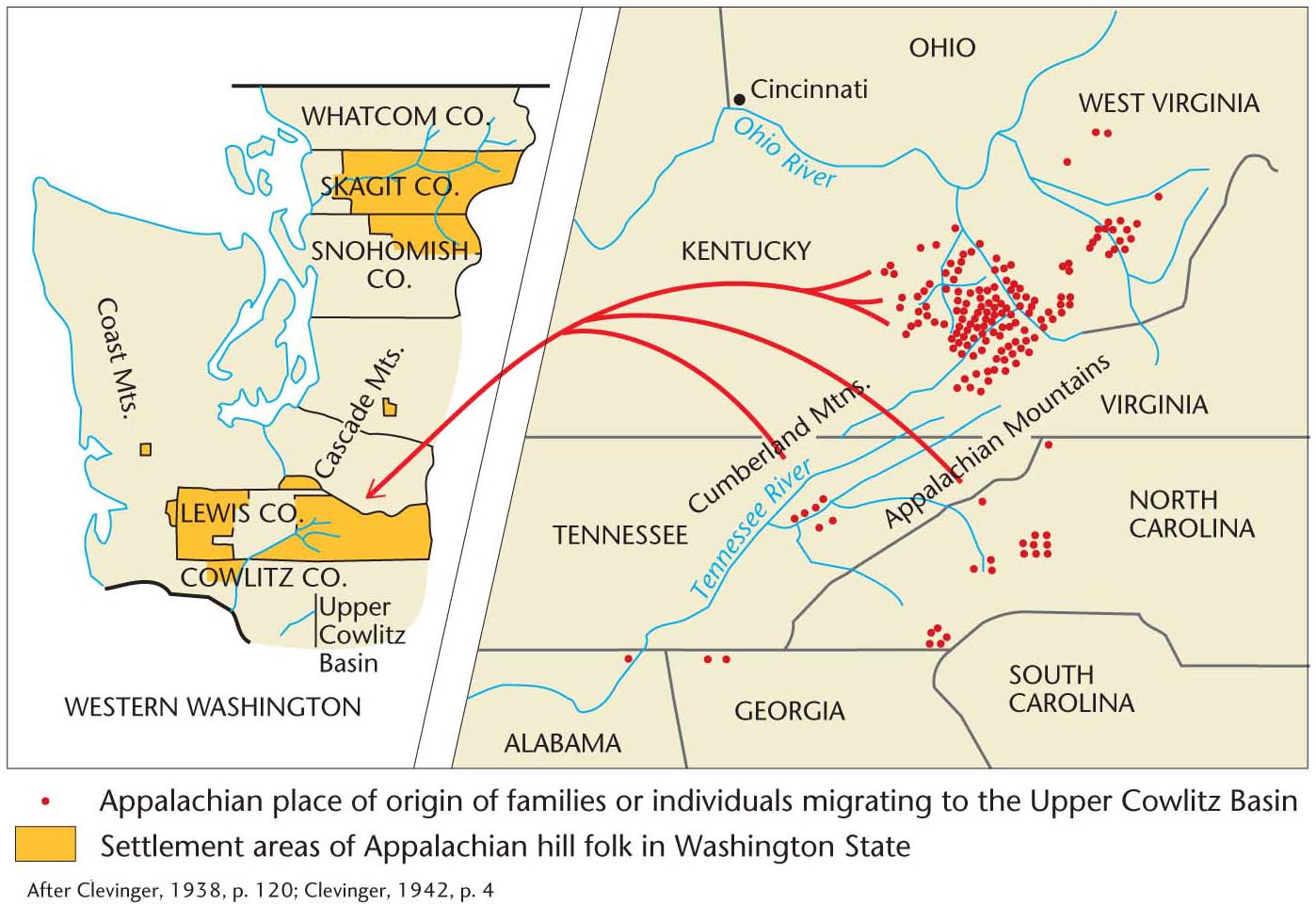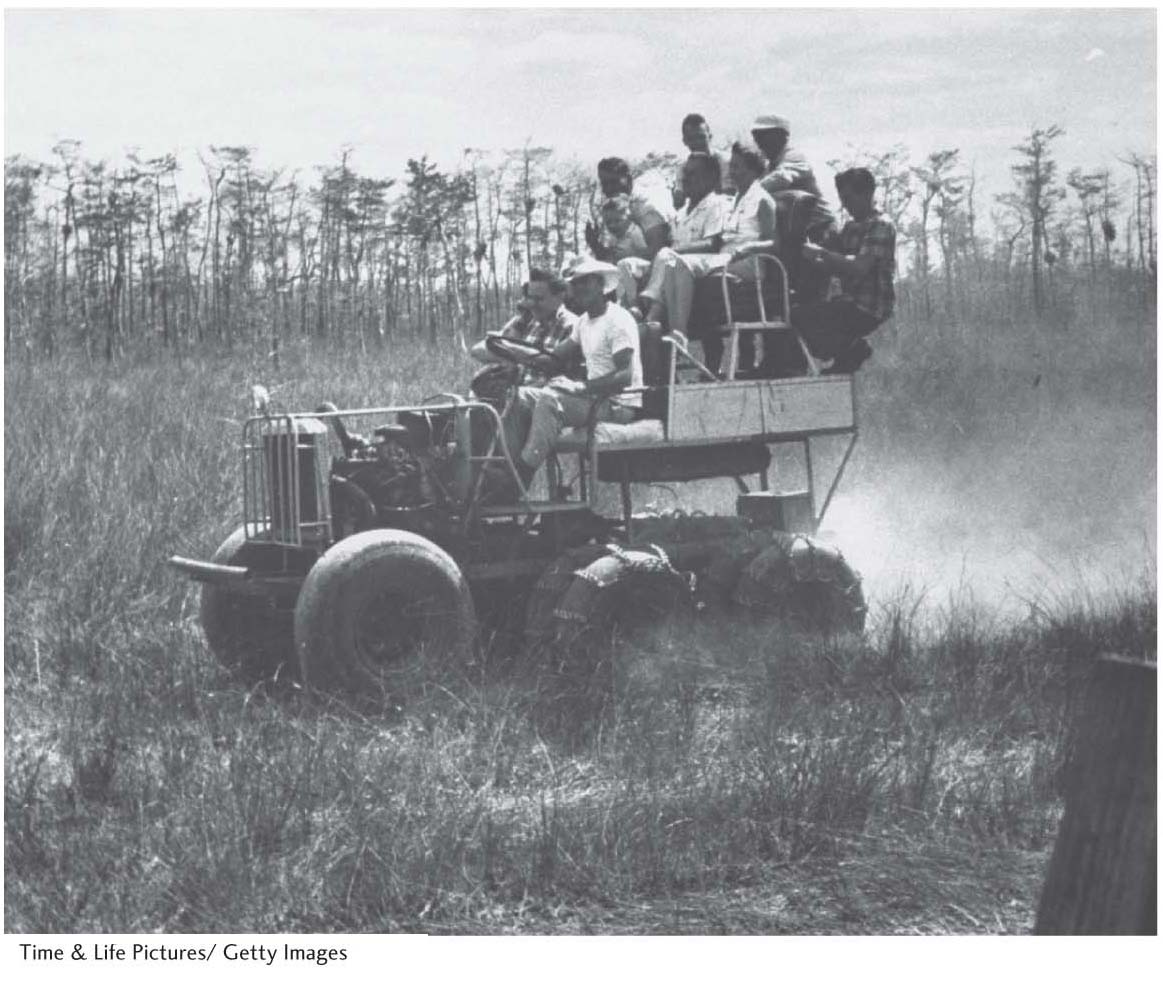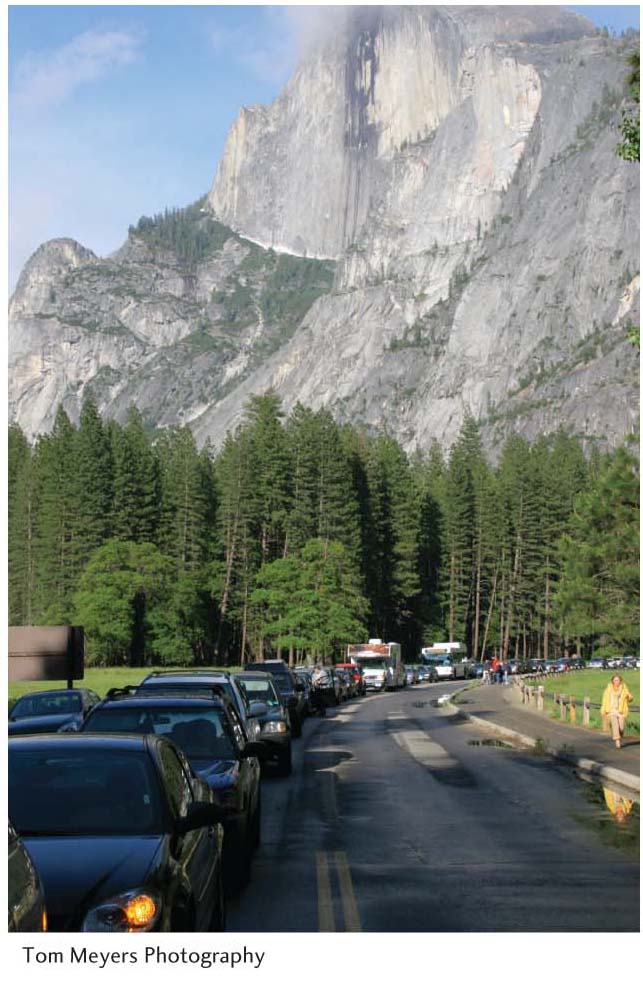NATURE-CULTURE
2.4
LEARNING OBJECTIVE
Identify the influence of culture on physical geography and physical geography on culture.
People who depend directly on the land for their livelihoods—farmers, hunters, loggers, and ranchers, for example—often have a different view of nature from those who work in the offices, schools, factories, and shopping malls of the cities. Let’s now look at the relationship between nature and cultural differences and how different cultures and subcultures differ in their interactions with the physical environment.
INDIGENOUS ECOLOGY
Many observers believe that indigenous peoples possess a close relationship with and a great deal of knowledge about their physical environment. In many cases, indigenous cultures have developed sustainable land-use practices over generations of experimentation in a particular environmental setting. As a consequence, academics, journalists, and even corporate advertisers frequently portray indigenous peoples as defenders of endangered environments, such as tropical rain forests. It was not always this way. Especially during the height of European colonialism, indigenous populations (then considered colonial subjects) were often accused of destroying the environment. The then-common belief that indigenous land-use practices were destructive helped Europeans justify colonialism by claiming they were saving colonial subjects from themselves. In hindsight, it is easy to see that this belief was related to now-discredited European ideas about the racial inferiority of colonized peoples.
colonialism
The forceful appropriation of a territory by a distant state, often involving the displacement of indigenous populations to make way for colonial settlers.
Debate continues today, with some observing that, although indigenous cultures may once have lived sustainably, globalization is making their knowledge and practices less useful. That is, globalization introduces new markets, new types of crops, and new technologies that displace existing land-use practices. Others note that it is impossible to generalize about sustainability in indigenous cultures because the way indigenous peoples use their environments varies from place to place and the indigenous societies are internally heterogeneous. A key discussion centers on the role of indigenous peoples in conserving the environment. The discussion is important because indigenous peoples often occupy territories of high biodiversity (Figure 2.42). Biodiversity refers to the biological diversity of the entire living world, as measured at various scales including diversity among individuals, populations, species, communities, and ecosystems. Biodiversity thus includes genetic diversity, species diversity, and habitat diversity.
biodiversity
Biological diversity of the entire living world, as measured at various scales including diversity among individuals, populations, species, communities, and ecosystems.

For example, many of the most biologically diverse areas in Latin America are under government protection in national parks and reserves. Eighty-five percent of these protected areas in Central America and 80 percent in South America contain resident indigenous populations. There is also a close geographic correspondence between indigenous territories and tropical rain forests in not only Latin America but also Africa and Southeast Asia. Tropical rain forests, although they cover only 6 percent of the Earth’s surface, are estimated to contain 60 percent of the world’s biodiversity. Thus, some see indigenous cultures as traditional caretakers of a precious resource. With the rise of genetic engineering, conservationists and corporations alike view tropical forests as in situ gene banks. That is, genetic diversity can be held in place in standing tropical forests as a reserve to be tapped in the future. As multinational biotechnology companies look to the tropics for genetic resources for use in developing new medicines or crop seeds, indigenous peoples are increasingly vocal about their proprietary rights over the biodiversity of their homelands.
Faced with these issues, cultural geographers emphasize the value of both the knowledge indigenous peoples bring to environmental management and of their land-use practices for sustainable development. Initially, geographers focused on how indigenous cultures adapted to ecological conditions. For example, some studied the social norms and land-use practices that helped certain cultures adapt to periodic drought. Later, they came to realize that external political and economic forces were just as important in shaping nature-culture relationships. A look at the work of a few key cultural geographers will illustrate the implications of this idea.
72
LOCAL KNOWLEDGE
Much of the interest in indigenous perceptions and practices falls under the category of indigenous technical knowledge (ITK). This is a concept that anthropologists and geographers developed to describe the detailed local knowledge about the environment and land use that is part of many indigenous cultures.
indigenous technical knowledge (ITK)
Highly localized knowledge about environmental conditions and sustainable land-use practices.
Geographer Paul Richards, for example, suggested that ITK is, in many cases, superior to Western scientific knowledge and, therefore, should be considered in environmental management and agricultural planning. For example, in his study of West African cultures, Indigenous Agricultural Revolution, Richards documented the subtle and extensive knowledge about local soils, climate, and plant life. This local-scale knowledge provides the foundation for people to experiment with new crops and agricultural techniques while also allowing them to adjust successfully to changing social and environmental conditions.
GLOBAL ECONOMY
ITK is place based. It is produced in particular places and environments through a process of trial and error that often spans generations. Thus, these local systems of knowledge are highly adapted to local conditions. Increasingly, however, the power of ITK is weakened through exposure to the economic forces of globalization. Sometimes the global economy applies such pressure to local subsistence economies that they become ecologically unsustainable. Subsistence economies are those that are oriented primarily toward production for local consumption, rather than the production of commodities for sale on the market. When an indigenous society organized for subsistence production begins producing for an external market, social, ecological, and economic difficulties often ensue.
subsistence economies
Economies in which people seek to consume only what they produce and to produce only for local consumption rather than for exchange or export.
73
Geographer Bernard Nietschmann’s classic study of the indigenous Miskito communities living along the Caribbean coast of Nicaragua showed how external markets can undermine local subsistence economies. Miskito communities had developed a subsistence economy founded on land-based gardening and the harvesting of marine resources, including green turtles. Marine resources were harvested in seasons in which agriculture was less demanding. The value of green turtles increased dramatically when companies moved in to process and export turtle products (meat, shells, leather). They paid cash and extended credit so that the Miskito could harvest turtles year-round instead of seasonally. Subsistence production in other areas suffered as labor was directed to harvesting turtles. Turtles became scarce, so more labor time was required to hunt them in a desperate effort to pay debts and buy food. Ultimately, the turtle population was decimated and the subsistence production system collapsed.
This study might sound like yet another tragic story of “disappearing peoples” or a “vanished way of life,” but it didn’t end there. Nietschmann continued his research with Miskito communities into the 1990s (he died in 2000), discovering, among other things, that the Miskito people did not disappear but continued to defend their cultural independence in the face of great external pressures from globalization. They responded to the collapse of their resource base in 1991 by creating, in cooperation with the Nicaraguan government, a protected area as part of a local environmental management plan. They were supported in this endeavor by academics, international conservation NGOs, and the Nicaraguan government. Known as the Cayos Miskitos and Franja Costera Marine Biological Reserve, it encompasses 5019 square miles (13,000 square kilometers) of coastal area and offshore keys with 38 Miskito communities. Through this program, the Miskito were able to regulate and control their own exploitation of marine resources while reducing pressures from outsiders. This is an ongoing experiment. Miskito communities continue to struggle with outsiders for control over their land and resources in the reserve. There are hopeful signs, however, that the government is cooperating in this struggle and that both the natural resource base and the Miskito people will benefit from this project.
The Miskito case demonstrates the resiliency of indigenous cultures, the limits of ITK, and the strength of global economic forces. It reflects recent studies of the cultural and political ecology of indigenous peoples, such as those conducted by geographer Anthony Bebbington. Bebbington conducted research among the indigenous Quichua populations in the Ecuadorian Andes to assess how they interact with modernizing institutions and practices. He found that, although the Quichua people often possess extensive knowledge about local farming and resource management, ITK alone is not sufficient to allow them to prosper in a global economy. For example, there is little indigenous knowledge about the way international markets work and thus little understanding of how to price and market their own produce. As a consequence, they have sought the support and knowledge of government agencies, the Catholic Church, and NGOs. He further found that indigenous Quichua communities use outside ideas and technologies to promote their own cultural survival, attempting, in essence, to negotiate their interactions with globalization on their own terms.
FOLK ECOLOGY
As with indigenous cultures, ideas persist about the particular abilities of folk cultures to sustainably manage the environment. Although the attention to conservation varies from culture to culture, folk cultures’ close ties to the land often produce detailed local ecological knowledge within folk groups. This becomes particularly evident when they migrate. Typically, they seek new lands similar to the one left behind. A good example can be seen in the migrations of Upland Southerners from the mountains of Appalachia between 1830 and 1930. As the Appalachians became increasingly populous, many Upland Southerners began looking elsewhere for similar areas to settle. Initially, they found an environmental twin of the Appalachians in the Ozark-Ouachita Mountains of Missouri and Arkansas. Somewhat later, others sought out the hollows, coves, and gaps of the central Texas Hill Country. The final migration of Appalachian hill people brought some 15,000 members of this folk culture to the Cascade and Coast mountain ranges of Washington State between 1880 and 1930 (Figure 2.43).

74
Although folk cultures have largely disappeared, the human inventiveness, curiosity, and need related to local ecologies remain, as we noted. Thus, there are many examples where local people derive what we might call folk solutions when confronted with a challenge of physical geography. The history of mountain bikes provides an example. Mountain bikes were invented when young men in the mountain regions of the Western United States attempted to figure out how to adopt existing technology to a new enterprise. Bikes were cannibalized for parts and reassembled into something new and local. Enthusiasts rode these single-speed “clunkers” with big balloon tires, careening down mountain trails and dirt roads in a sport that did not yet have a name. Eventually, these locally imagined, hand-assembled clunkers became the rough prototypes of today’s mass-produced mountain bikes. Another good example is the swamp buggy, a folk solution to the problem of navigating in and around the Everglades and associated wetlands of southern Florida (Figure 2.44). Local hunters in southwest Florida needed a way to access wildlife. In the 1940s they came up with a solution that involved installing huge balloon tires, oversized suspension, and other modifications on pickup trucks. Jacked up high, these vehicles are able to move through standing water and over rough terrain in a way that no mass-produced vehicle can. They remain the best solution to the challenge of local geography and are a common sight in the south Florida wetlands landscape.

NATURE AND GENDER
We noted in Chapter 1 and earlier in this chapter that cultures are heterogeneous and that gender is a key marker of difference within places and regions. Geographers and other social scientists have documented significant differences between men’s and women’s relationships with the environment. This observation holds for many different types of cultures. Ecofeminism is one way of thinking about how gender influences our interactions with nature. This concept, however, might seem to suggest that there is something inherent or essential about men and women that makes them think about and behave toward the environment in particular and different ways. Although cultural geographers would argue against such essentialism, few would disagree that gender is an important variable in nature-culture relations.
ecofeminism
A doctrine proposing that women are inherently better environmental preservationists than men because the traditional roles of women involve creating and nurturing life, whereas the traditional roles of men too often necessitate death and destruction.
75
Diane Rocheleau’s work on women’s roles in the management of agroforestry systems makes this point. Agroforestry systems are farming systems that combine the growing of trees with the cultivation of agricultural crops. Agroforestry is practiced by folk and indigenous cultures across the tropical world and has been shown to be a highly productive and ecologically sustainable practice. It is common in these production systems for men and women to have very distinct roles. Generally, for example, women are involved in seeding, weeding, and harvesting, whereas men take responsibility for clearing and cultivation. Gender differences also often exist in the types of crops men and women control and in the marketing of produce.
agroforestry
A cultivation system that features the interplanting of trees with field crops.
After conducting studies for many years—first in East Africa and later in the Dominican Republic—Rocheleau was able to see general themes regarding the way human-environment relations are different between men and women in not only agroforestry systems but also many rural and urban environments. Together with two colleagues, she identified three themes: gendered knowledge, gendered environmental rights, and gendered environmental politics. First, because women and men often have different tasks and move in different spaces, they possess different and even distinct sets of knowledge about the environment (gendered knowledge). Second, men and women have different rights, especially with regard to the ownership and control of land and resources (gendered environmental rights). Third, for reasons having to do with their responsibilities in their families and communities, women are often the main leaders and activists in political movements concerned with environmental issues (gendered environmental politics). Taken together, these themes suggest that environmental planning or resource management projects that do not address issues of gender are likely to have unintended consequences, some of them negative for both women and environmental quality.
NATURE IN POPULAR CULTURE
Popular culture is less directly tied to the physical environment than are folk and indigenous cultures, which is not to say that it does not have an enormous impact on the environment. City dwellers generally do not draw their livelihoods from the land. They have no direct experience with farming, mining, or logging activities, though they could not live without the products and materials produced from those activities. Gone is the intimate association between people and land once known by past folk generations. Gone, too, is our direct vulnerability to many environmental forces, although this security is counter-balanced by new risks. Because popular culture is so tied to mass consumption, it can have enormous environmental impacts, such as the production of air and water pollution and massive amounts of solid waste. Also, because popular culture fosters limited contact with and knowledge of the physical world, usually through recreational activities, our environmental perceptions can become quite distorted. (See Rod’s Notebook.)
76
Popular culture makes heavy demands on ecosystems. This is true even in the seemingly harmless activity of outdoor recreation. Recreational activities have increased greatly in the world’s economically affluent regions. Many of these activities require machines, such as snowmobiles, off-road vehicles, and jet skis, that are powered by internal combustion engines and have numerous adverse ecological impacts ranging from air pollution to soil erosion. In national parks and protected areas worldwide, affluent tourists in search of nature have overtaxed protected environments and wildlife and produced levels of congestion approaching those of urban areas (Figure 2.45).

Such a massive presence of people in our recreational areas inevitably results in damage to the physical environment. A study by geographer Jeanne Kay and her students in Utah revealed substantial environmental damage done by off-road recreational vehicles, including “soil loss and long-term soil deterioration.” One of the paradoxes of the modern age and popular culture seems to be that the more we cluster in cities and suburbs, the greater our impact on open areas because we carry our popular culture with us when we vacation in such regions.